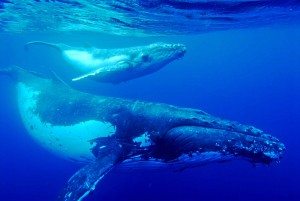Snorkeling with whales on the Great Barrier Reef is an experience to remember. The gentle giants sing their mysterious songs and swim up to observers on their own. They oftentimes stare into the eye of the observer, almost as if to try to communicate.
Please check your feed, the data was entered incorrectly.I always love a chance to go watch some beautiful wildlife in their natural habitat and to me nothing beats the amazing feeling I get when the wild creature is actually interested in me too.
Oftentimes when going whale watching, I feel like some strange stalker, but when in the water with them I feel as if we’re actually communicating. It makes me feel validated in special way. I think it is an experience everyone should try at least once. Especially if they already have a love of whales.
Going whale watching is already pretty awesome in itself but here on the Great Barrier Reef, is one of the few places in the world where you can go swimming with them.
During winter time, approximately from June to September is when you are more likely to see Humpback and Dwarf Minke Whales. These are the best times to book trips. However, the whale experiences are quite popular, so you should definitely email us if you intend on going so we can make sure to arrange the best experience possible.
The best part of these magical encounters is that, obviously we don’t have control over the whales or their path so they get to decide if they want to meet us and as it happens, Minke Whales are very curious about boats and swimmers and they will come as close up as a meter to check you out!
Getting There:
The best trips to see the Minke Whales are on Mike Ball’s Dive Adventures and Spirit of Freedom Liveaboards. You should schedule early and call or message us directly if you would like to get any more information on this experience.
About the Whales on the Great Barrier Reef:
The Great Barrier Reef is a nursery for the whales and they are oftentimes enjoying the warm waters while they get their baby whales (calves) ready to swim to the subarctic waters where they feed. There are over 30 kinds of whales on the Great Barrier Reef, but the Dwarf Minke Whales and the Humpback whales are the most common.
Dwarf Minke Whales are one of the more mysterious species on the reef and not a lot is known about them. They are the more curious whales that will actually come up to you while you are just sitting in the water. While Dwarf Minke whales are the smallest baleen whales, they still get up to 8 meters in length. They spend much of their time feeding in the arctic waters between December to March. They are seen in the waters of the Great Barrier Reef between March and October, but 90% of the sightings are in June and July. It is usually the ‘teenager’ whales that are the most curious to check out the curious divers. Minke Whales feed off of krill and schooling oceanic fish, but are not known to feed on the Great Barrier Reef. If you are interested in Learning more about Minke Whales, I strongly encouraging looking at Project Dwarf Minke Whale Project website: http://www.minkewhaleproject.org/
Humpback whales are from 12-16 meters in length. Even when you do not see them, you can oftentimes hear them ‘singing’ in the water with their magical song they are famous. Sightings are year round for the Humpback whales, but June to September are the months they are most commonly seen.
While whale sightings are common in the Great Barrier Reef Marine Park, they have been hunted down to an estimate 2% of their previous populations. Seeing and snorkeling or diving with the whales will hopefully inspire people to be more vocal about helping preserve these magnificent creatures.
The good news is that with the end of commercial whaling, populations have been gradually recovering over the years. Many of the locals in the area have seen firsthand the populations gradually increasing over the years. Every year there are sightings of more whales migrating through the waters. We hope they will one day return to their original populations, but they still have a long way to go.
